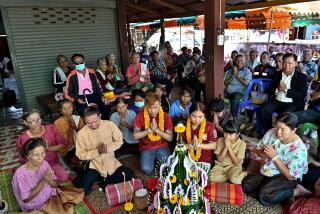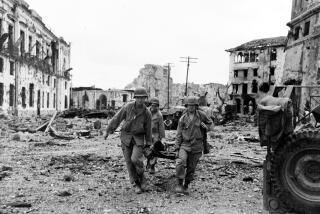Delay of Attack Gave Philippine Rebels an Edge
- Share via
MANILA — Throughout June, police officers from an elite anti-crime unit trickled onto Jolo island, where kidnappers were holding 20 foreign hostages. They arrived in twos and threes on the overnight ferry, wearing civilian clothes, their guns hidden in scruffy duffel bags, and slipped into an abandoned warehouse near the waterfront until finally, on June 25, their numbers had grown to 180.
Their strike against the Abu Sayyaf bandits was scheduled for June 28, a Muslim feast day when rebel leaders were likely to be visiting their families. The plan, Philippine intelligence sources said, was to take out the guards at the jungle hut where the hostages had been languishing for two months. Then, the captives, covered with bulletproof blankets, would be taken to helicopters and flown to safety.
Though supported by President Joseph Estrada’s defense advisors, the operation on the island in the southern Philippines was canceled at the eleventh hour because Estrada was concerned about hostage casualties as well as international repercussions if the mission failed.
The reprieve had huge implications for both the government and the rebels, leading to Estrada’s decision to launch an all-out attack against the rebels over the weekend.
The 20 foreigners, along with one Filipino, had been kidnapped by the Abu Sayyaf rebels in April from a Malaysian diving resort and were taken by speedboat to Jolo. Most of the hostages were released over the next five months--in exchange for millions of dollars in ransom.
Abu Sayyaf used the money to buy new equipment and weapons, which has helped the rebels increase the size of their force tenfold since June. They then took new hostages--19 in all, including two French journalists and an American.
Fed up with the wave of kidnapping, Estrada ordered the weekend attack. The kidnappers fled with their captives deeper into the jungle, and officials said Monday that at least four civilians and eight rebels had been killed since the fighting started.
Officials said they remained optimistic that many of the hostages would turn up safe. But observers say the new money, equipment and recruits will make it difficult for the army to crush the kidnappers. A news blackout remained in effect on many of the details of the military operation.
Abu Sayyaf, or “Father of the Sword,” an Islamic group that says it is fighting for an independent Muslim state in the southern Philippines, has left a trail of blood and burned villages across the region. In June, when the government assault was originally planned, the group had only about 200 members. But over the next 10 weeks, ransom money--about $15 million in all and mostly from Libya, which had previously financed the rebels--poured in as the hostages’ freedom was won in groups of three and four. Before long, the kidnappers were the richest people on an impoverished island.
Flush with cash, they recruited more than 2,000 young men at handsome salaries. They bought bazookas, mortars and rifles. They roared through the hills on new motorcycles, crashing often. Commander Robot, a former bodyguard whose real name is Ghalib Andang, celebrated his enriched status as the rebel leader by taking another wife, his fourth.
The rebels even started a rudimentary navy, buying a 50-seat speedboat capable of outrunning the Philippine navy’s patrol boats, which are hand-me-downs from the United States.
Unkempt teenage recruits began appearing on the streets of Jolo island wearing gold necklaces, Nike sneakers and polo shirts. Merchants rushed to the island from the mainland, and their supplies of fake Rolexes and Ray Ban sunglasses sold quickly. Business was so brisk that the local bank ran out of pesos and Robot had to send two aides to the city of Zamboanga, on nearby Mindanao island, with a suitcase containing $240,000 in $100 U.S. bills. When the aides tried to exchange the money for local currency, a leery teller called the police and they were arrested.
“Abu Sayyaf claims to be fighting for Islam in the southern Philippines, but its real activity is kidnapping,” said Asiri Abubakar, a professor of Asian studies at the University of the Philippines. “They created a boomtown in Jolo with the ransom money, and with the resources they’ve got now, it will be hard to neutralize them, as the military says it intends to do.”
Only one of the captives--a Philippine resort worker--remains from the original group that the elite police unit had set out to save.
Estrada’s patience with the rebels had run out, and he ordered the weekend assault after Abu Sayyaf released the last four foreign captives from the original group--two Finns, a German and a Frenchman --on Sept. 9. The next day, the rebels returned to Malaysia, grabbed three local workers from another resort island and brought them to Jolo. The rebels carried out this kidnapping in their new speedboat.
During the assault, Philippine soldiers and marines quickly overran Abu Sayyaf’s abandoned base camp in the jungled hills above the town of Jolo. But the guerrillas had fled with their captives, and the troops have been pursuing the rebels while artillery and warplanes maintain their bombardment.
“Estrada’s popularity has soared in attacking Abu Sayyaf,” said Alexander Magno, a university political and military analyst. “But the military is going to have to produce something with this spectacle. The whole Philippine navy is at Jolo. There are eight F-5s in the air, 5,000 troops on the ground. The public expects some kind of dividend, which usually means a body count.”
The 250,000-member Philippine armed forces, with a combat strength of about 120,000, are respected for their professionalism but are among the most ill-equipped in Southeast Asia. Their armaments, such as the patrol boats, generally are secondhand items no longer wanted by the U.S., and the government’s defense spending is the lowest on a per capita basis in the region.
Abu Sayyaf burst into the headlines in 1995 when it attacked the village of Ipil in a Muslim area of the Philippines, killing at least 54 civilians. It went on to kidnap dozens of Filipinos over the years, collecting modest ransoms. Its original leader, Abdujarak Abubakar Janjalani, was killed in a shootout with police in 1998.
Last March, a separate faction of Abu Sayyaf rebels seized about 50 schoolchildren, teachers and priests on nearby Basilan island, killing six of them, including two by beheading. After the guerrillas ignored three warnings to release the survivors, Estrada ordered an air and land attack that destroyed the rebel base April 22. The next day, the 21 hostages were seized in Malaysia.
More to Read
Sign up for Essential California
The most important California stories and recommendations in your inbox every morning.
You may occasionally receive promotional content from the Los Angeles Times.










